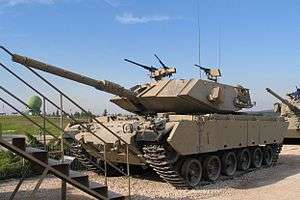M60 Patton
| M60 | |
|---|---|
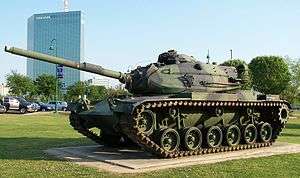 An M60A3 on display in Lake Charles, Louisiana, in April 2005. | |
| Type | Main battle tank |
| Place of origin | United States |
| Service history | |
| In service | 1960–present |
| Used by | See Operators |
| Wars | |
| Production history | |
| Manufacturer | Detroit Arsenal Tank Plant, Chrysler |
| Produced |
M60: 1960–1962 M60A1: 1962-1980 M60A2: 1969-1975 M60A3: 1978-1983[4] |
| No. built | Over 15,000 (all variants) |
| Variants | See Variants |
| Specifications | |
| Weight |
M60: 50.7 short tons (46.0 t; 45.3 long tons) M60A1: 52 to 54 short tons (47 to 49 t; 46 to 48 long tons) depending on turret design. |
| Length | M60: 6.946 meters (22 ft 9.5 in) (hull), 9.309 meters (30 ft 6.5 in) (gun forward)[5] |
| Width | M60: 3.631 meters (11 ft 11.0 in)[5] |
| Height | M60: 3.213 meters (10 ft 6.5 in)[5] |
| Crew | 4 |
|
| |
| Armor |
Upper Glacis[6]
|
Main armament |
|
Secondary armament |
|
| Engine |
Continental AVDS-1790-2 V12, air-cooled Twin-turbo diesel engine 750 bhp (560 kW)[5] |
| Power/weight | 15.08 bhp/st (12.4 kW/tonne)[5] |
| Transmission | General Motors, cross-drive, single-stage with 2 forward and 1 reverse ranges[5] |
| Suspension | Torsion bar suspension |
| Ground clearance | 1 foot 6.2 inches (0.463 m)[5] |
| Fuel capacity | 385 U.S. gallons (1,457 L)[5] |
Operational range | 300 miles (500 km)[5] |
| Speed | 30 mph (48 km/h) (road)[5] |
The M60 Patton is a main battle tank (MBT) introduced in December 1960.[8] With the United States Army's deactivation of their last (M103) heavy tank battalion in 1963, the M60 became the Army's primary tank[9] during the Cold War. Although developed from the M48 Patton, the M60 series was never officially classified as a Patton tank, but as a "product-improved descendant" of the Patton series.[10] In March 1959, the tank was officially standardized as the 105 mm Gun Full Tracked Combat Tank M60. Over 15,000 M60s were built by Chrysler. Hull production ended in 1983, but 5,400 older models were converted to the M60A3 variant ending in 1990.[4]
The M60 underwent many updates over its service life. The interior layout, based on the design of the M48, provided ample room for updates and improvements, extending the vehicle's service life for over four decades. It was widely used by the U.S. and its Cold War allies, especially those in NATO, and remains in service throughout the world today, despite having been superseded by the M1 Abrams in the U.S. military. Egypt is currently the largest operator with 1,716 upgraded M60A3s, Turkey is second with 866 upgraded units in service, and Israel is third with over 700 units of Israeli variants.
Development
Impetus
During the Hungarian Revolution of 1956, a Soviet T-54A medium tank was driven onto the grounds of the British embassy in Budapest by the Hungarians.[11] After a brief examination of this tank's armor and 100 mm gun, British officials decided that their 20 pounder was apparently incapable of defeating it. There were also rumors of an even larger 115 mm gun in the works. Hence there was a need to adopt a more powerful gun, which emerged as the famed 105 mm Royal Ordnance L7.[12]
This information made its way to the United States, where the Army had been experimenting with a series of upgrades to their M48 Patton tanks. These experiments were concerned with improving the armor, rangefinders, and the introduction of a variety of autoloader systems, such as that used in the 105 mm gun tank T54.
The T95 program, launched after the Questionmark III conference in June 1954, was the intended replacement to the M48. It featured a host of innovative and experimental components such as its 90 mm smoothbore T208 cannon rigidly affixed to its turret, and its new powertrain and suspension. The burden of developing them, however, slowed the overall program to a crawl. General Taylor approved of a new tank development program in August 1957. This incorporated many ARCOVE recommendations and foresaw the eventual replacement of the light, medium, and heavy tanks with two types: the airborne reconnaissance/assault vehicle, and the main battle tank (MBT).
The MBT was to combine the firepower and protection sufficient for the assault role with the mobility to perform as a medium tank.[13] A tank of the T95 series, armed with a smoothbore cannon and powered by a compression ignition engine, was envisaged by the Army Staff as the bearer of the role of future MBT.[14] Some T95 hulls were used from 1960 to 1964 to develop the T118E1 prototyping of the M728 Combat Engineer Vehicle.[15]
The course of this tank program was the source of widespread debate. The Bureau of Budget (BOB) believed that the Army was not progressing with sufficient speed in its tank modernization program and recommended the immediate replacement of the M48A2. Correctly predicting that the BOB would not approve the procurement of the M48A2 after the fiscal year of 1959, the Deputy Chief of Staff, Logistics (DCSLOG) proposed a tank based on the M48A2 featuring improved firepower and the AVDS-1790 engine.
The alternative was to introduce a tank from the T95 series, but it remained highly experimental with its compression ignition engine not as developed as the AVDS-1790. An influential group of senior officers, by May 1958, concluded that the T95 had only marginal advantages over the M48A2. They proposed that the most important improvements, better firepower and fuel economy, could be achieved by mounting a compression ignition engine and a more powerful gun on the M48A2.[14]
Choice of components
M68 105mm Main Gun
The main gun was chosen after a comparative firing test on the Aberdeen Proving Grounds. Participating in the test were six guns: the 90 mm M41 (armament of the M48A2 although tested with the new T300E53 HEAT round), the 90 mm T208E9 (a smoothbore weapon firing T320E62 APFSDS), the 105 mm X15E8 (a British gun developed from the 20 pdr), the 105 mm T254 (an American gun firing the same APDS ammunition as that of the British), the 120 mm T123E6 (a lightened variant of the M58), and the 120 mm M58 (armament of the M103). The 120 mm T123E6 was preferred by the Ordnance Department because its ammunition, the same as that for the M58 gun, was already at an advanced state of development.[16] The T123E6 however had a slow rate of fire as, unlike the M58 on the M103, there would be only be one loader servicing it.[17] This led to the weapon having a max rate of fire of 4 rpm vs. the T254's 7 rpm.[18] The factors evaluated were accuracy, lethality of a hit, rate of fire and penetration performance. Based on these tests, the 105 mm T254E2 was selected and standardized as the M68. It used a vertical sliding breechblock instead of the L7's horizontal breechblock, and the US gun was fitted with an eccentric bore evacuator instead of a concentric model in order to provide more clearance over the rear deck.[19] Until American-made tubes could be obtained with comparable accuracy, British tubes were to be used.[17]
Armor
Composite armor made with fused silica glass was intended on the turret and the hull. This composite armor provides protection against HEAT, HEP, and HE rounds. However, repaired castings suffered a loss of kinetic energy protection.[20] This led to the front of the hull taking the shape of a flat wedge, instead of the M48's elliptical front, as it simplified the installation of this armor.[14] Limitations in manufacturing capacity and the added cost however led to this special armor being dropped and all M60 series tanks were protected with conventional steel armor.[21]
M19 Commander's Cupola
The commander's cupola's official nomenclature is the Cupola, Tank Commander's Caliber .50 Machine Gun, M19.[22] Initial production of the cupola was problematic. The first 300 M60s produced were armed with a .50cal M2HB machine gun in a pedestal mount welded to the left side of the commander's cupola owing to production problems with the new M85 machine gun. Of these tanks, the first 45 manufactured were made without the cupola itself, also due to production problems.[23] All of these early M60s eventually had the M19 cupola and M85 machine gun installed.
Compared to a conventional pintle mount, the remote-controlled M85 machine gun was relatively ineffective in the anti-aircraft role for which it was designed. Removing the cupola lowered the vehicle's relatively high silhouette. The cupola's hatch also opened toward the rear of the vehicle and was dangerous to close if under small-arms fire owing to a lock-open mechanism that required the user to apply leverage to unlock it prior to closing.[24] All M60s in US service retained the M19 cupola until the tank was phased out of service. The few M60A3s in Army service as training vehicles had their commander's cupola removed as it was deemed unnecessary for training and to better mimic the profile of Soviet tanks.
Initial versions
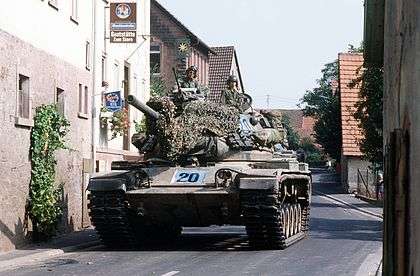
In 1957, plans were laid in the US for a universal or all purpose tank.[13] Fulfilling this requirement with an interim tank resulted in the M60 series,[25] which largely resembles the M48 it was based on, but has significant differences. The M60 mounted a 105 mm M68 main gun with the bore evacuator mounted towards the middle of the tube, compared with the M48's 90 mm M41, which mounted the bore evacuator towards the end of the tube right after its T-shaped muzzle brake. It also had a hull with a straight front slope whereas the M48's hull was rounded, had three support rollers per side to the M48's five, and had road wheels constructed from aluminum rather than steel, although the M48 wheels were often used as spare parts.
The improved design incorporated a Continental V-12 750 hp (560 kW) air-cooled, AVDS-1790-2 diesel engine, extending operational range to over 300 miles (480 km) while reducing both refueling and servicing. Power was transmitted through a CD-850-6 cross drive transmission, a combined transmission, differential, steering, and braking unit.
The hull of the M60, like its predecessor the M48, could be cast as a single piece or by welding smaller castings. The turret was similar to the M48A2's and was made as a single piece casting although it was modified to accept the new larger diameter cupola and the M116 mount for the 105 mm gun.[26] The hull was divided into three compartments, with the driver in front, fighting compartment in the middle and engine at the rear.[27] The driver looked through three M27 day periscopes, one of which could be replaced by an M24 infrared night vision periscope.[27] The vehicle also provides full NBC protection for the crew using the M13A1 protection system. It can produce a limited smokescreen by dumping raw diesel fuel into the exhaust system to visually obscure the area around the vehicle. The smokescreen does not provide protection against infrared, thermal or laser detection.[28]
The M60 was the last U.S. main battle tank to utilize homogeneous steel armor for protection. It was also the last to feature an escape hatch under the hull. The escape hatch was provided for the driver, whose top-side hatch could easily be blocked by the main gun. Access between the driver's compartment and the turret fighting compartment was also restricted, requiring that the turret be traversed to the rear.[29]
Originally designated the XM60, the new vehicle was put into production in 1959, standardized as the 105 mm Gun Full Tracked Combat Tank M60 on 16 March 1959,[30] and entered service in 1960.[31] There was a proposal in April 1959 to change the nomenclature to 105 mm gun main battle tank M60; this was however rejected due to a conflict with the Federal Cataloging Agency Policy.[30] In May 1960 the Army awarded Chrysler a $60 million contract for the production of 720 tanks.[32] In May 1961 Army Chief-of-Staff General George Decker announced that the European Command would begin receiving the M60 to replace older tank inventory.[33] By October the Seventh Army was outfitted with many of the tanks.[34] A 1964 Government Accounting Office report, disputed by the Army, said Berlin garrison M60s were not equipped with needed anti-tank ammunition when construction of the Berlin Wall began in 1961.[35] In March 1962 the Army awarded Chrysler a $28.4 million contract for the production of 305 tanks,[36] followed in October with a $61.2 million contract for 720 more.[37]
M60A1 series
Approved in March 21, 1960 was the initial program that led to the M60A1.[38] This new variant was first produced in October 1962[8] and stayed in production until 1980. While the M60 continued to use the turret based on the M48A2's, T95E7 style turrets were not abandoned. Work continued on an elongated turret based on its design. The turret, even without the siliceous cored armor, provided improved ballistic protection. Additional space for the turret crew was also made available by mounting the cannon 5" forward.[38] In addition to the added protection offered by this turret on production M60A1s, the upper glacis armor was increased from 3.67 inches to 4.29 inches at 65 degrees while the sides over the crew compartment went from 1.9 inches to 2.9 inches at their apex.[39] This brought the frontal armor up to the same 10" line of sight armor standard of the M103 heavy tank.[40] Shock absorbers were installed in the first two and last road wheel arms. The uncomfortable wire mesh seats were replaced by padded seats. The brake and accelerator pedal were rearranged for more efficient and comfortable operation while the steering wheel was replaced by a T bar steering control.[41] The engine and power train were upgraded by the addition of the Continental AVDS-1790-2A and the CD-850-6A. The new engine lowered fuel consumption and smoke emissions. Combination day-IR periscopes were introduced, the M32 for the gunner and the M36 for the commander although the commander's periscope could be substituted with the M34 for binocular vision without IR.[42]
As development of a new main battle tank stalled with problems and cost escalating quickly, the M60A1 was forced to serve longer than originally intended with production lasting over 20 years. In that time span numerous product improvement programs were put forward. The first of which was TLAC, for Top Loading Air Cleaner. This reduced dirt and dust ingestion, which increased engine life. Its top loading configuration also made it easier to service.[43] Next came the AOS meaning Add-On Stabilization that was introduced in late 1972.[43] As its name implies, this was an add on stabilizer kit made to fit with minimum modifications to the existing hydraulic gun control system. It was made up of several components: the rate sensor package, a control selector box, the electronics package, a shut-off valve, the traverse servo-valve assembly, the elevation servo-valve assembly, the handle shaping assembly, an hydraulic filter, and an antibacklash cylinder. At short to medium ranges, hit probabilities better than 50% from a moving M60A1 were obtained in Aberdeen test results while without a stabilizer it was essentially zero. M60A1(AOS) was the designation received by M60s equipped with the TLAC, AOS and the new T142 steel track, which had replaceable rubber pads and improved service life.[44]
In 1975, the M60A1(RISE) meaning Reliability Improved Selected Equipment was introduced. Its AVDS-1790-2C diesel engine featured several changes in order to improve service life and reliability: new top-loading air cleaners; stronger cylinders; improved starter, fuel injection lines, and nozzles; and better turbosuperchargers. A new 650 ampere oil cooled alternator, a solid state regulator and new wiring harness with more accessible disconnect were also incorporated into its electrical system.[44] The M60A1(RISE)(PASSIVE), which debuted in 1977, featured passive night vision sights for gunner and commander, a new night vision device for the driver and a deep water fording kit.[45]
M60A2 "Starship"
The M60A2 was intended as a stop-gap solution until the projected replacement by the MBT-70.[46] The M60A2, nicknamed the "Starship"[47] due to its "Space Age" technology, featured an entirely new low-profile turret with a commander's machine-gun cupola on top, giving the commander a good view and field of fire while under armor but spoiling the low profile. It featured a 152 mm (6.0 in) main gun similar to that of the M551 Sheridan light tank, which fired conventional rounds as well as the MGM-51 Shillelagh anti-tank missile system.
In May 1969 the Government Accounting Office reported that despite indications that the tank had faults, the Army had rushed production of the M60A2 to avoid budgetary scrutiny in Congress. Technical problems including turret stabilization issues had sidelined 300 M60A2s, ordered in 1966, in storage while the Army worked on a fix.[48] The fitting of a CBSS (closed breech scavenger system), which used pressurized air to clear the breech after each shot, solved the problem of unburnt propellant from the main gun rounds fouling the barrel and pre-detonating subsequent rounds.
The M60A2 proved a disappointment, though technical advancements would pave the way for future tanks; the MBT-70, which relied on much of this technology as it was used in the M60A2, never advanced beyond prototype stage. The Shillelagh/M60A2 system was phased out from active units by 1981, and the turrets scrapped. Most of the M60A2 tanks were rebuilt as M60A3, or the hulls converted to armored vehicle-launched bridge (AVLB) vehicles and M728 Combat Engineer Vehicles.[47]
M60A3 series
In 1978, work began on the M60A3 variant. It featured a number of technological enhancements, including smoke dischargers, a new flash-lamp pumped ruby-laser based rangefinder (AN/VVG-2) that could be used by both commander and gunner, an M21 ballistic computer, and a turret stabilization system.

Foreign upgrades
Late in the US M60's service, several prototype upgrades were evaluated. These were passed over in favor of simply producing more M1 Abrams. The M60A3 was phased out of US service in the 1990s and as a training aid in 2005,[49] but it has remained a front-line MBT into the 21st century for a number of other countries. In 2005, M60 variants were in service with Bahrain, Bosnia, Brazil, Egypt, Greece, Israel, Jordan, Portugal, Spain, Tunisia, Turkey, Thailand, ROC (Taiwan), Iran, and some other nations to varying degrees. Most of these are highly upgraded and modified, notable examples are the Magach, Sabra and Phoenix variants.
Super M60/AX
The Super M60/AX, also called "Super 60", was a comprehensive update package for the M60 Patton series tanks, first offered in 1985 by General Dynamics. The weapons of the Super M60 are similar to those of the M60A3 Patton, but different models are used. The main gun is a rifled 105 mm/L52 M68A1 with a thermal sleeve, the same weapon used on the M1 version of the Abrams MBT with 63 rounds. The prototype built did not have an optical range finder but one could have been easily installed. The 7.62 mm M73 coaxial machine gun used on the M60A3 is replaced with a 7.62 mm M240C, with the same number of rounds. The turreted 12.7 mm M85 machine gun was replaced with a manually-fired 12.7 mm M2HB with 600 rounds. Survivability was enhanced with a layer of Chobham spaced applique armor built around the M60 turret, dramatically changing its appearance. A layer of laminated steel armor covers the frontal arc, and possibly the sides and/or rear as well. A pair of steel track skirts were added and spall liners as standard. The electronics package of the Super M60 is largely the same as that of the M60A3, with an AN/VVG-2 laser rangefinder, an AN/VVS-2 thermal imaging system, and an M21 digital ballistic computer. Maneuverability was improved by a Teledyne Continental Motors CR-1790-2B, a 1,180 hp V12 diesel engine, mated to a Allison-Renk RK 304 automatic transmission with 4 forward and 4 reverse gears. The suspension of the Super M60 is enhanced over the plain torsion bars of the M60A3 Patton via hydropneumatic struts. The new struts not only smoothen the ride, but also allow the Super M60 to handle well in spite of its considerable weight increase over the original M60 Patton. Even though this update package offered M60 users an opportunity to dramatically increase the combat power of their tank fleets, no country ever bought the update, and the program effectively ceased by the end of the Cold War. Only one prototype was built. The failure of the Super M60 program was likely due to the lack of immediate necessity for such a vehicle.[50]
General Dynamics offered the M60-2000 Main Battle Tank in 2001.[51]
M60/AX-120 Super Scorpion
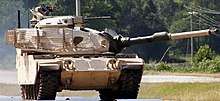
In 2013, General Dynamics Land Systems was contracted to do a redesigned turret and hull for the Spanish Army to bring them up to standard. Early work began in 2010 as the M60/AX-120 Super Program. The lethality upgrade included a Super 60 turret that mounted a licensed version of the M256 L/44 120mm Smoothbore main gun (locally built and designated as the Modelo 44 120mm Smoothbore) carrying 60 rounds. The original M85 machine gun in the commander's turret was replaced with a manually controlled FN M3M .50 cal Heavy Machine Gun with 600 rounds and the mounting of a ATK LW25 25 mm chain gun towards the rear of the turret on a Remote Weapon Station, the Loader also has a pintle mounted M249 Mk3 5.56 mm Light Machine Gun used for local defense, and has two six barreled electronically fired M250 smoke dischargers, one on each side of the main gun. An Integrated Fire Control System as developed by Cascadia Optronics and FLIR Systems was fitted to the tank to provide a similar capability to the M1 Abrams Mark 1 Advanced Fire Control System. Mobility enhancements included an upgraded Allison CR-1790-3A 1800 hp Diesel Engine and Allison-Renk RK 304 Final Drive Assembly automatic transmission with 4 forward and 4 reverse gears, new drive sprockets and roadwheels, as well as the T158 lightweight track as used on the Abrams and the installation of hydropneumatic struts. Also cameras were mounted on the hull front, rear and sides for situational awareness, similar to the Abrams Situational Awareness Package (ASAP). Survivability was enhanced with the addition of Slat/Cage Armor around the turret to defeat RPGs and other explosives fire along with protection plates to the frontal arc. The side skirts are made of composite material and lighter than the older steel skirts previously used. An optional offering was the fitting of Blazer Explosive Reactive Armor.
Most of the M60A3s still in service with Spain were modified to this standard, some are still used by Guard and Reserve units of the Spanish Army. The M60A3-120 Super Scorpion, now known as the Alacrán (Spanish for Scorpion) was shown at the International Arms Expo held in Germany in 2013. These upgraded hulls were also used to construct improved M60 AVLBs and the Alcrán combat engineer vehicles for the Spanish Army.[52]
M60A3 SLEP
Raytheon introduced its own service life extension program (SLEP) package for the M60A3 in 2016.[53] Lethality upgrades offered in this package include a fully stabilized M68 120 mm/L44 smoothbore gun fitted with a load assisting system allowing a maximum rate of fire of 6-10 rounds per minute. It is fitted with Raytheon's Integrated Digital Fire Control System consisting of a modular sighting system including a Day TV camera, an Infra Red (IR) camera for night vision and an eye-safe Laser Range Finder and data bus to improve first round hit probability. Raytheon also fitted it with a laser warning receiver and smoke grenade dischargers. The cupola and M85 machine gun have replaced with the Hitrole remotely controlled weapon system, that enables 360° panoramic surveillance from a secure position inside the tank armed with a M2HB .50cal Heavy Machine Gun as well as replacing the M73 coaxial machine gun with a M240C. The hydraulic turret stabilization system has been replaced with the fully electro-mechanical Curtiss-Wright’s Electric Gun Turret Drive Upgrade Kit. This allows the tank turret to rotate faster and accurately fire while the tank is on the move and is also lighter and safer, as a result of the removal of flammable hydraulic fluids in the turret. Its mobility has been improved with an upgraded AVDS-1790-2C engine producing 950 hp increasing available power by 20%, thus achieving improved power-to-weight ratio despite the weight increases. The suspension system includes an improved hydropneumatic system. The installation of an Automatic Fire and Explosion Sensing and Suppressing system (AFSS) that improves soldier survivability and protects the engine compartment as standard. Upgraded armor protection with STANAG 4569 Level 6 protection plates to the frontal arc and side skirts and slat armor added to the bustle, protecting the rear of the turret from RPG attack. These changes increased the vehicle weight to 62-63 tons.[54][55]
Raytheon has been working with Jordan’s King Abdullah II Design and Development Bureau (KADDB) for the past three years on its Phoenix Level 1 IFCS upgrade and Level 2 Lethality upgrade efforts for the M60 main battle tank. A $46.6M contract with the Jordan Armed Forces was authorized to upgrade one battalion of their Phoenix main battle tanks with Raytheon’s Integrated Fire Control System (IFCS).[56]
Leonardo M60A3
The Leonardo M60A3 is an upgraded variant of the M60A3 offered by Italian defense company Leonardo. The upgrade is intended to offer nations already operating the M60 an upgrade to their vehicles to offer capabilities more in line with third-generation main battle tanks. It was unveiled 17th October 2017 at the Bahrain International Defense Exhibition and Conference (BIDEC).
Upgrades offered in this package include a new 120/45 gun from the Centauro II that offers a weight saving of 500kg over the older 120/44 gun due to a redesigned light alloy cradle and muzzle brake. The old commander’s cupola is completely removed and replaced instead with an armored circular ballistic plate protected with slat armor. This also offers a weight reduction compared to the original M19 cupola as used on the A3 Patton. For close defense, the turret is also fitted with the HITROLE-L 12.7mm remotely operated weapons system. The turret has been refitted with a new set of hydraulic and servo control improving performance. The rest of the vehicle is completely overhauled including the torsion bars, brakes, fuel supply, electric system, wheels, seals, paint, and smoke grenades. The vehicle has also been retrofitted with the Automatic Fire and Explosion Sensing and Suppression System (AFSS). Its is equipped with the LOTHAR gun sight, DNVS-4 Driver’s Night Vision Sight and TURMS digital fire control system. a daytime TV camera, and an eye-safe Laser Range Finder. IED jamming systems an a laser warning receiver systems developed by Leonardo are optionally offered.
Armor improvements include a whole new passive protection suite fitted around the M60’s existing cast armor turret and hull that is claimed to meet STANAG Level 6 standards. Protection for the turret is optimized for protection against kinetic energy (KE) weapons and artillery across the frontal arc. The hull to is upgraded to the same standard with the protection covering the hull sides extending to the third roadwheel. For the rear of the turret, slat armor is provided with an emphasis on protecting against the RPGs.
Mobility is improved via either a full refurbishment of the existing power packs or an upgrade. The new powertrain offered is stated to deliver up to 20% more power without high costs and avoiding the need for any modifications to the existing hull. This AVDS-1790-5T+CD-850-B1 908 hp engine replaces the 750hp engine and is connected to an upgraded CD-850-6A transmission.[57][58][59]
Service History
United States
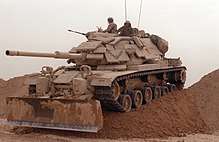
Fifteen of the early examples of the M60 produced had insufficiently thick hull armor, and were therefore used by the Armor School at Fort Knox to train tank crewmembers and maintenance personnel.[60]
The M60 AVLB and M728 Combat Engineer Vehicle were the only variants of the M60 series deployed to South Vietnam during the Vietnam War. The M728 was used in fire support, base security, counter ambush fire, direct assault of fortified positions, and limited reconnaissance by fire.[61] The AVLB provided gap crossing capabilities when required to support armored forces. M60s were deployed at this time to West Germany during the Cold War to support US Army operations and participated in annual REFORGER exercises as well as Allied Forces Day parades in West Berlin until 1991.
They participated in Operation Urgent Fury in 1983. U.S. Marines from G Company of the 22nd Marine Assault Unit equipped with Amphibious Assault Vehicles and four M60A1 Patton tanks landed at Grand Mal Bay and relieved the Navy SEALs the following morning, allowing Governor Scoon, his wife, and nine aides to be safely evacuated. The Marine tank crews faced sporadic resistance, knocking out a BRDM-2 armored car. G Company subsequently overwhelmed the Grenadian defenders at Fort Frederick.[62] The 1st Battalion, 8th Marine Regiment deployed with M60A1s to Beirut and were present during the subsequent 1983 Beirut barracks bombings near the Beirut International Airport.[63]
The M60A3 participated in close air support trials with the F-16 in the 1980s. M60A1s have been used by the USAF for testing of ground radar equipment on new aircraft and for ground force adversarial work during Exercise Red Flag at Nellis AFB Nevada.[64][65]

During Operation Desert Storm in the Gulf War of 1991, at least one US Air Force unit was equipped with M60s. The 401st TFW (P), deployed to Doha, Qatar had two M60s for use by explosives ordnance disposal personnel. It was planned that using the MBTs would allow the EOD crews to remove unexploded ordnance from tarmac runway and taxiway surfaces with increased safety.[66]
In early February 1991, 200 US Marine M60A1s of the 1st Marine Expeditionary Force (1MEF) drove north from Khafji, Saudi Arabia into Kuwait. In the Battle of Kuwait International Airport they encountered an Iraqi force of T-54, T-55, T-62, Type 69, and T-72 tanks. The Marines won the battle, destroying some 100 Iraqi tanks with only one M60A1 lost (to anti-tank mines).[67] The U.S. Marines M60A1s were fitted with add-on explosive reactive armor (ERA) packages.[68]
Following the end of both the Cold War and Operation Desert Storm, the M60 was rapidly withdrawn from combat use and superseded by the M1A1 Abrams by both the Army and Marine Corps and was relegated to the Army National Guard through most of the 1990s. In May 1997, at Fort Riley, 1st Battalion, 635th Armor, Kansas Army National Guard, retired the last M60 series tanks in the US military. The 58 M60A3 tanks of the Kansas Guard's only armor battalion were unceremoniously parked in a holding pen at the Camp Funston Mobilization and Training Equipment Site (MATES), in the Kansas River Valley, down the hill from Fort Riley's main post.[69] They were later transferred to the Jordanian Army.
Due to the end of the Cold War, surplus US Army M1s were absorbed by the US Marines replacing the M60 on a one for one basis, allowing the Marine Corps to quickly become an all-M1 tank force at reduced cost. Except for a small number in service for training, most M60s were placed in reserve, with a few being sold to US allies.
After being retired from combat use in 1991, 18 M60A3s, with the M19 cupola removed, continued in active Army service to provide tactical combat training to US and NATO forces in Europe. They were fitted with the Multiple Integrated Laser Engagement System (MILES), given the mission to provide tactical engagement simulation for direct fire force-on-force training and were maintained at the Combat Maneuver Training Center (CMTC) near Hohenfels, Germany. They were used in the OPFOR Surrogate (OPFOR(S)) role by D Company 1st Battalion, 4th Infantry Regiment (Team Dragon) until 2005.[70] After their service as training aids, these examples were demilitarized and placed as target hulks on various firing ranges at the Grafenwoehr Training Area.[71]
The US military continues to have significant stockpiles of M60s waiting to be scrapped, sold off, converted, used as targets in weapons testing, or used for radar objects for jet attack planes. They are also salvaged for parts to maintain other vehicles still in service. One M60A1 hull was leased to General Dynamics for development of the M60-2000/120S during 2000-2001.[72] The M68 105mm Gun has been used for the M1128 Stryker MGS. Some 100 M60s are to be placed as artificial reefs off New Jersey and the Gulf coasts of Florida and Alabama accessible to scuba divers.[73][74] In February 2017, the United States Army awarded a contract to BAE Systems and Land Armaments to convert several former M60 tanks to M88A2 recovery vehicles.[75]
Israel

The Israel Defense Forces (IDF) purchased its first M60A1 tanks from the US in 1971. M60s and M60A1s saw action with Israel during the 1973 Yom Kippur War in both the Sinai and the Golan Heights (although mainly in the Sinai). The United States sent additional M60s to Israel just before and during hostilities. Israel had about 150 M60A1 tanks in service at the start of the war. Many Israeli M60s were destroyed by Egyptian troops with AT-3 Sagger anti-tank missiles in the first few days after Egyptian forces crossed the Suez Canal. The tank is highly regarded in Israeli service and been praised for its firepower and maneuverability.[67][76][77][78][79]
Following the war, the IDF received many more M48s, M60s and M60A1s from the U.S. Israel further upgraded their inventory of M60s through the 1970s and into the 1980s. The Israeli modifications included new tracks, a modified cupola and explosive reactive armor (ERA). This variant was known as the Magach 6.[80] Further work in Israel has been done on the upgraded Magach 7 models, adding new armor, new fire control system, a thermal sleeve, and smoke dischargers. The latest versions, the Magach 7 (with variants A and C), still used by some IDF units.
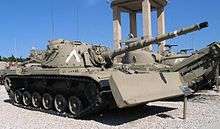
In the 1982 Lebanon War (Israeli Operation Peace in Galilee), Magach 6s encountered Syrian T-54/55 and T-72s as well as PLO T-34s. Some were destroyed by Syrian infantry hunter-killer teams with ATGMs and supplemented by RPG-7s. Several others were damaged by HOT missiles fired from Syrian Gazelle helicopters. One Magach 6 was destroyed by a T-72 and another was abandoned by its crew after taking damage.[67]
In July 2013, Israel began the Teuza (boldness) program for turning some military bases into sales lots for obsolete IDF equipment. Older models not suited for Israel's forces are to be sold off, or sold for scrap if there are no buyers. The E60 and early model Magach tanks are among those being offered. Main buyers are expected from Latin American, Asian, and African countries.[81]
With the disbanding of the last M60-equipped battalions in 2014, the tank is no longer in service with the Israel Defense Forces.[82] However the M60 hull and chassis are still used for the Magach 6/7 tank and other vehicles. A small number of M60A1 AVLBs are still in service with the IDF.[83]
Other users

Extensive numbers of M60 tanks served within the Iranian military during the Iran–Iraq War, with varying combat success during the eight years of attrition and campaigning.[84] One of the first M60 tanks delivered to Iran was hijacked to the Soviet Union in 1961. The information garnered led to the development of the T-62.[85]
In the early 70s, the Argentine Government acquired a single M60 for evaluation for possible service with the Argentine military. It was never placed into service. It stands as a monument at the Argentinian Army's NCOs Academy, in Campo de Mayo, near Buenos Aires.
The M60 has served with the Saudi Arabian Army.[86][87] They saw action as part of the Coalition Forces during the Gulf War, particpating in the Battle of Khafji as well as in the Shia insurgency in Yemen.[88][89]
Spain received some 400 M60A3 MBTs in 1991-92, when redundant American equipment became available as a result of the TLE (Transfer of Limited Equipment) Treaty. The Ministry of Defense in 1995 under the Armor 2000 program has been replacing M60s in Spanish service with the Leopard 2 A5 MBT. Some have been converted into the M60CZ-10/25E Alacran and AVLBs.[90]
Bosnia received its initial 45 M60A3s as a result of a transfer from Iran in 1994, covertly bypassing the arms embargo that was in place due to the ongoing Bosnian War.[91] An additional 40 more were received in 2012.
Royal Thai Army M60A3s were engaged in combat to recapture Border Post 9631, some two miles west of the city of Thachilek, from Myanmar Army forces in 2001. On 10 February, the Thai 3rd Cavalry Regiment assembled a battalion-sized task force from a part of a mechanized infantry battalion armed with M113A3 APCs, an infantry company and a company of M60A3 MBTs and reportedly exchanged fire with Type 69 tanks.[92][93][94]
Sudan obtained its 20 M60A1s from Iran in 2004 spending around 8 million dollars.[95]
Greece offered to donate 13 M60A3 tanks to Afghanistan in 2007.[96] In 2011, Greece was interested in buying M1 Abrams tanks from US stocks as replacements for its M60s. However, the deal was cancelled because Greece lacked adequate funding.[97]
The Lebanese Armed Forces (LAF) entered discussions with Jordan to acquire M60A3 MBTs in 2008 to replace its older M48s and T-55s. These transfers required approval under the US Third Party Transfer (TPT) from the US Central Command (USCETCOM). However Lebanon's leadership was apprehensive about a second transfer of 46 A3s because of its dissatisfaction with the first 10 tanks received from Jordan in May 2009. The United Arab Emirates committed $17 million to pay for the transfers, but by the end of 2009 had not provided the funds and has not yet fully committed the $98 million to finance the remaining 56 tanks, for a total of between 56 to 66 tanks.[98]
Approximately 80 M60 and Sabra tanks of the Turkish Army, jointly with Syrian rebel factions of the Free Syrian Army (FSA) conducted Operation Euphrates Shield (ES) beginning in August 2016, aiming to clear an area of 5,000 square kilometers of Syrian territory controlled by ISIS forces. During the fighting in and around the city of Al-Bab in December the Turkish 16th Mechanized Brigade lost at least one M60A3 due to a ATGM missile with reports that the driver suffered minor injuries (concussion and hearing loss).[99][100] They have bought Leopard 2s in 2005 from stocks made redundant by German military cutbacks to begin the process of replacing M60s still in service as well as developing its own Atlay MBT.[101]
In October 2017, Taiwan abandoned attempts to acquire surplus M1 Abrams from the U.S. and announced an upgrade program for 450 of its M60A3s, consisting of replacing the main gun with a new 120 mm cannon, as well as upgrading the ballistics computer, changing turret hydraulics to electric, and other systems. Testing and evaluation are expected to be completed in 2019 and application of new features to start in 2020.[102] In May 2018, Taiwan's Minister of National Defense told a legislative panel they are still interested in purchasing an initial 108 U.S. surplus M1A2 Abrams tanks, enough to equip two battalions.[103]
Egypt has employed its M60s in participation of semi-annual Bright Star exercises. Egypt's military has stationed troop and armor assets to the Sinai and Gaza border in early 2018 to quell Islamist terrorist activity and destroying many of the tunnels used by Hamas to bring supplies into Gaza. According to Egypt Defense Portal, the vehicles, which include YPR-765 armored infantry fighting vehicles and 30 M60 main battle tanks, were stationed near Gaza in preparation for an expanded military campaign in the framework of Comprehensive Operation Sinai 2018, which began last February.[104][105]
Variants
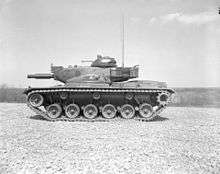
- XM60/M60: Bearing a strong familial resemblance to the M48, it has a wedge shaped hull, three return rollers, and aluminum road wheels, features not found on previous M48s. Featured a turret with 105 mm M68 gun. Some early production units did not have the commander's cupola.[106]
- M60A1: First variant to feature the distinctive "needle-nose" long nosed turret, along with better armor protection and improved hydraulics.[107]
- M60A1 AOS: Add-On Stabilization, introduced in 1972 for the M68 gun.[108]
- M60A1 RISE: Reliability Improvements for Selected Equipment, featured improvements of almost all the basic systems including an upgraded engine design that allowed easier access to components to allow removing the engine pack in less time and a new track type, T142, that helped reduce wear and improve track life.
- M60A1 RISE Passive: RISE, but with a smaller infra-red/white light capable search-light and passive night vision equipment. USMC M60A1 RISE Passives were outfitted with explosive reactive armor (ERA) in the late 1980s.[109]
- M60A1E1: Developmental test vehicles fitted with the 152 mm M162 gun-missile launchers.[110]
- M60A1E2/M60A2: Turret design finalized, giving the distinctive "starship" look. A variant was tested with a remote controlled 20 mm cannon as well.
- M60A1E3: prototype, M60A1E2 fitted with 105 mm gun.
- M60A1E4: Experimental type with remote control weapons.[111]
- M60A3: M60A1 fitted with a laser rangefinder, M21 solid state ballistic computer, and a crosswind sensor. Late production E60s for foreign military sales omitted the commander's cupola.[112]
- M60 Super/AX: General Dynamics upgrade package for the M60A3. One prototype built.
- M60-2000/120S: M60/Abrams hybrid vehicle developed by General Dynamics Land Division. One prototype built.
Specialized
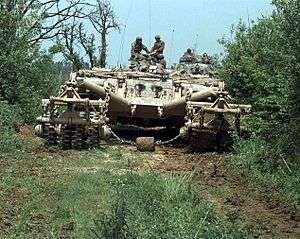
- M60 AVLB: armored vehicle-launched bridge with 60-foot (18 m) scissors bridge mated to the M60 hull.
- M60 Panther: A remote controlled mine clearing vehicle with turret removed, mine rollers on front, and the Standardized Teleoperation System..[115]
- M88 Recovery Vehicle: Armored recovery vehicle based on M60 chassis.
- M728 Combat Engineer Vehicle: Combat Engineer Vehicle fitted with a folding A-frame crane and winch attached to the front of the turret, and an M135 165mm demolition gun mated to the M60 hull.
International
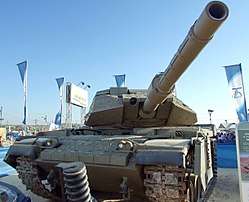
- M60T or Sabra: highly upgraded variant of the M60A1 which is designed for the MBT modernization program of the Turkish Army. It features a new 120 mm smoothbore gun, electric stabilization system, new fire control system, and new armor package.[116][117] M60T is also known as Sabra Mk. II.
- E60: Foreign Military Sales designation for the M60 series
- E-60: basically unmodified main production M60
- E-60A: basically unmodified M60A1
- E-60B: basically unmodified M60A3, late production examples w/o M85 coupla
- M60VLPD 26/70E: Spanish Army bridgelayer based on the M60 with "Leguan bridge system". 12 converted from M60A1.
- M60CZ-10/25E Alacran: Spanish Army combat engineer variant. 38 converted from M60A1..[118]
- Israeli variants: Many of the Israeli M60s have been upgraded with additional reactive or passive armor, drastically improving their armor protection. These up-armored versions are called Magach 6 / Magach 7.
- M60 Phoenix: Jordanian upgrade, being carried out by the King Abdullah II Design And Development Bureau.[119] Upgrade includes shoot-on-move capabilities, increased firepower (with a RUAG 120 mm smoothbore gun) and armor protection scheme upgrade.
- Samsam (Sword): Iranian upgraded version of M60A1 tank, fitted with reactive armor (presumably Kontakt-5), EFCS-3 Fire Control system, Laser warning system and IR jammers.[120]
Operators
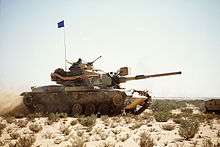
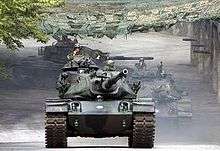
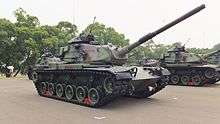
.jpg)





















Former operators



.svg.png)
.svg.png)
See also
- G-numbers: (SNL G292)
- Gun data computer: models M16, M19, M21
- Magach 6 & 7: series of Israeli upgrades to the M60 platform
- Shawn Nelson: Went on a rampage in Clairemont, San Diego, in a stolen M60A3
Tanks of comparable role, performance and era
- AMX-30: French main battle tank
- Chieftain: British main battle tank
- Leopard 1: German main battle tank
- Stridsvagn 103: Swedish turret-less main battle tank
- T-62: Soviet main battle tank
- T-72: Soviet main battle tank
- TR-85: Romanian main battle tank
- Type 69/79: Chinese main battle tank
- Type 74: Japanese main battle tank
- Vijayanta: Indian main battle tank
References
- ↑
- ↑ Yemeni Houthi forces ATGM attack on a Saudi tank (apparently M60 Patton) on YouTube
- ↑ "Cerablus'ta tanka roket atıldı: 1 asker şehit oldu". NTV (in Turkish). Istanbul, Turkey: Doğuş Media Group. Anadolu Ajansı. 27 August 2016. Retrieved 14 September 2016.
- 1 2 "M60 Series Tank (Patton Series)". Fas.org. Retrieved 2018-09-11.
- 1 2 3 4 5 6 7 8 9 10 Foss 2005, p. 166
- 1 2 Hunnicutt 1984, pp. 439–443
- ↑ TM 9-1000-213-35 Direct Support, General Support, and Depot Maintenance Manual for Cannon, 105-mm Gun, M68, Mount, Combination Gun, M116 and M140, and Cupola, Tank Commander's Caliber .50 Machine Gun, M19 Used on: Tank, Combat, Full Tracked: 105-mm Gun, M60A1 W/E (2350-756-8497) and Tank, Combat, Full-tracked: 105-mm Gun, M60 W/E (2300-00-678-5773). Washington, D.C.: Dept. of the Army, 8 July 1975.
- 1 2 Hunnicutt 1984, p. 165
- ↑ Hunnicutt 1988, p. 181
- ↑ Hunnicutt 1984, pp. 6, 408
- ↑ http://www.historynet.com/the-beast-of-budapest.htm
- ↑ Zaloga 2004, pp. 13, 39
- 1 2 Hunnicutt 1984, p. 149
- 1 2 3 Hunnicutt 1984, p. 150
- ↑ Tank Data, vol. 3. Aberdeen Proving Ground, MD: US Army Ordnance School, Jul 1968.
- ↑ Hunnicutt 1984, p. 153
- 1 2 Hunnicutt 1984, p. 155
- ↑ Hunnicutt 1984, pp. 453–454
- ↑ TM 9-2350-253-20-2 Organizational Maintenance Manual--Tank, Combat, Full Tracked: 105-mm Gun, M60A3 (2350-00-148-6548) and (2350-01-061-2306) TTS Turret. Washington, D.C.: Dept. of the Army, 15 April 1980
- ↑ Salter, Charles B.; Spiro, Harry (8 November 1958). "Evaluation of Siliceous Cored Armor for the XM60 Tank". Defense Technical Information Center. Fort Belvoir, VA: United States Department of Defense. Technlical Report No. 11733. Accession Number: AD0524050. Retrieved 9 September 2015.
- ↑ Hunnicutt 1984, p. 156
- ↑ TM 9-1000-213-35 Direct Support, General Support, and Depot Maintenance Manual for Cannon, 105-mm Gun, M68, Mount, Combination Gun, M116 and M140, and Cupola, Tank Commander's Caliber .50 Machine Gun, M19 Used on: Tank, Combat, Full Tracked: 105-mm Gun, M60A1 W/E (2350-756-8497) and Tank, Combat, Full-tracked: 105-mm Gun, M60 W/E (2300-00-678-5773). Washington, D.C.: Dept. of the Army, 8 July 1975.
- ↑ Crismon, Fred W. U.S. Military Tracked Vehicles. Osceola, WI: Motorbooks International, 1992
- ↑ https://www.onwar.com/weapons/afv/data/usambtm60a3.htm
- ↑ Hunnicutt 1984, p. 152
- ↑ Hunnicutt 1984, p. 158
- 1 2 Antill, Peter D. (7 March 2001). "M60 Patton Main Battle Tank (USA)". Military History Encyclopedia on the Web. Egremont, UK. Retrieved 26 March 2010.
- ↑ TM 9-2350-253-20-2 Organizational Maintenance Manual--Tank, Combat, Full Tracked: 105-mm Gun, M60A3 (2350-00-148-6548) and (2350-01-061-2306) TTS Turret. Washington, D.C.: Dept. of the Army, 15 April 1980
- 1 2 3 "105mm Gun Tank M60 - Tank Encyclopedia". www.tanks-encyclopedia.com.
- 1 2 Hunnicutt 1984, p. 157
- ↑ Foss 2002, pp. 232–233
- ↑ "$103,000,000 Pacts Awarded By Army". The New York Times. UPI. 24 May 1960. Retrieved 19 August 2018.
- ↑ "Army to Get New Tank; M-60s for Berlin Garrison Announced at Fete". The New York Times. 21 May 1961. Retrieved 19 August 2018.
- ↑ Baldwin, Hanson (6 October 1961). "U.S. Seventh Army; Strengths and Weaknesses Noted In NATO's Key Ground Defender". The New York Times. Retrieved 19 August 2018.
- ↑ "U.S. Lack of Firepower In Berlin in '61 Bared". The New York Times. UPI. 4 March 1964. Retrieved 19 August 2018.
- ↑ "Contract Awards". The New York Times. 3 March 1992. Retrieved 19 August 2018.
- ↑ "Contract Awards". The New York Times. 13 October 1962. Retrieved 19 August 2018.
- 1 2 Hunnicutt 1984, p. 168
- ↑ Hunnicutt 1984, p. 174
- ↑ Hunnicutt 1988, p. 205
- ↑ Hunnicutt 1984, p. 169
- ↑ Hunnicutt 1984, p. 440
- 1 2 Hunnicutt 1984, p. 199
- 1 2 Hunnicutt 1984, p. 200
- ↑ Hunnicutt 1984, p. 202
- ↑ United States. Congress. House. Committee on Armed Services (1978). Hearings, Reports and Prints of the House Committee on Armed Services, Issue 56. Washington, D.C.: United States Government Publishing Office. p. 8961. Retrieved 19 February 2011.
- 1 2 "Development and History of the M-60 tank". Patton-Mania. Duesseldorf, Germany: Andreas Hueger. Retrieved 10 September 2016.
- ↑ Sheehan, Neil (15 May 1969). "Army Accused of Rushing Work On Tanks to Avoid Budget Study". The New York Times. Retrieved 19 August 2018.
- 1 2 Murray, Ben (22 May 2005). "Hohenfels trades 'The Butcher' for new 'Tonka tank'". Stars and Stripes. Washington, D.C.: Defense Media Activity. Retrieved 13 November 2014.
- ↑ http://www.military-today.com/tanks/super_m60.htm
- ↑ http://www.military-today.com/tanks/120s.htm
- ↑ http://ciar.org/ttk/mbt/armor/armor-magazine/armor-mag.1998.ma/2spain2000.pdf
- ↑ https://defense-update.com/20171026_m60_upgrades.html
- ↑ https://defense-update.com/20171026_m60_upgrades.html
- ↑ https://www.defensenews.com/2016/06/05/raytheon-breathes-new-life-into-patton-tanks/
- ↑ http://www.defense-aerospace.com/articles-view/release/3/30073/jordan-to-update-tank-fire-control-%28dec.-9%29.html
- ↑ http://www.tanks-encyclopedia.com/modern/Italy/leonardo-m60a3-upgrade-solution/
- ↑ http://www.leonardocompany.com/en/-/hitfact-105-120mm
- ↑ http://www.leonardocompany.com/en/-/hitrole-light
- ↑ Crismon, Fred W. U.S. Military Tracked Vehicles. Osceola, WI: Motorbooks International, 1992
- ↑ "M728 Combat Engineer Vehicle". inetres.com.
- ↑ https://www.mca-marines.org/gazette/operation-urgent-fury-revisited
- ↑ "THE FORGOTTEN Marine Barracks Bombing Beirut, Lebanon October 23, 1983 - Marine Patriot Blog". 23 October 2017.
- ↑ Pike, John. "Red Flag". www.globalsecurity.org.
- ↑ Gibson, Michael. "M60 Series Main Battle Tank - ISO-Group.com". M60 Tank Parts.
- ↑ Kopack, Mike. "The Gulf War with the 401TFW/614TFS Lucky Devils". Archived from the original on 17 December 2014. Retrieved 10 September 2016.
- 1 2 3 Henson, Jason W. "M-60 Patton / Magach-6/7 MBT". The HarpoonHQ Database & Encyclopedia Web Application. Archived from the original on 18 October 2014. Retrieved 13 February 2015.
- ↑
- 1 2 Pike, John. "M60 Series Tank (Patton Series)". www.globalsecurity.org.
- ↑ "M60 Patton Tank". Military Forces. Retrieved 18 June 2018.
- ↑ "Grafenwohr Army Base - Army Technology".
- ↑ http://www.military-today.com/tanks/120s.htm
- ↑ http://www.chicagotribune.com/news/ct-xpm-1994-09-25-9409250103-story.html
- ↑ http://www.aquaexplorers.com/tanks.htm
- ↑ "U.S. Army purchases additional HERCULES vehicles".
- ↑ Gawrych 1996, pp. 43–50
- ↑ Ḥammād 2002, pp. 176–177
- ↑ O'Ballance, p. 104
- ↑ el-Shazly, Saad, p. 233
- 1 2 "Magach 6". www.israeli-weapons.com.
- ↑ "Israeli army is planning to sell second-hands Merkava main battle tanks and F-16 fighter aircraft". Army Recognition. Ramillies, Belgium. 16 July 2013. Retrieved 12 September 2016.
- 1 2 "Israeli military retires Patton tanks". Jaffa Port, Tel Aviv, Israel: i24news. 25 April 2014. Archived from the original on 7 July 2016. Retrieved 12 September 2016.
- 1 2 "Trade Registers". armstrade.sipri.org.
- ↑ Karsh 2002, pp. 1–8, 12–16, 19–82
- ↑ Zaloga 2004, p. 13
- ↑ Isby & Nordeem 2010, p. 73.
- ↑ Zaloga 2009, pp. 46-47.
- ↑ CNN, Gulf War Facts.
- ↑ Williams, pp. 5–6.
- ↑ http://ciar.org/ttk/mbt/armor/armor-magazine/armor-mag.1998.ma/2spain2000.pdf
- ↑ https://fas.org/irp/congress/1996_rpt/bosnia.htm#pg1
- ↑ http://burmanewsandarticles.blogspot.com/2007/12/burma-air-force-jet-fighters.html
- ↑ https://www.theguardian.com/world/2001/feb/13/thailand
- ↑ http://www.acig.info/CMS/index.php
- ↑ https://www.humanrightsfirst.org/wp-content/uploads/pdf/CAH-081001-arms-table.pdf
- ↑ "Greece". MacDill Air Force Base, Tampa, FL: United States Central Command. Archived from the original on 10 June 2011. Retrieved 12 September 2016.
- ↑ https://limitofadvance.wordpress.com/2016/01/17/η-νέα-αεροπορία-στρατού-τι-περιλαμβάν/
- ↑ https://www.globalsecurity.org/military/world/lebanon/army-modernization.htm
- ↑ https://www.bellingcat.com/news/mena/2017/02/12/battle-al-bab-verifying-turkish-military-vehicle-losses/
- ↑ https://www.aljazeera.com/news/2017/09/large-convoy-turkish-troops-gathers-syria-border-170917121843145.html
- ↑ https://militaryedge.org/articles/turkey-mulling-upgrade-leopard-2s-m60s/
- ↑ Giving up on Abrams tank acquisition, Taiwan moves to upgrade its M60A3 tanks - Defensenews.com, 6 October 2017
- ↑ Keck, Zachary (May 5, 2018). "Taiwan Wants American M1 Abrams Tanks. And the Reason Is China". The National Interest. Retrieved August 18, 2018.
- ↑ http://www.israelnationalnews.com/News/News.aspx/171869
- ↑ http://www.israeldefense.co.il/en/node/34029
- ↑ Hunnicutt, R.P. Patton: A History of the American Main Battle Tank, volume 1. Navato, CA: Presidio Press, 1984
- ↑ Decker, Oscar C. "The Patton Tanks: The Cold War Learning Series." Camp Colt to Desert Storm: The History of U.S. Armored Forces. Eds. George F. Hofmann, Donn A. Starry. USA: University Press of Kentucky, 1999.
- ↑ Jane's Tank Recognition Guide, 1996, ISBN 0-00-470995-0
- ↑ http://www.fas.org/man/dod-101/sys/land/m60.htm
- ↑ Hunnicutt, R.P. Patton: A History of the American Main Battle Tank, volume 1. Navato, CA: Presidio Press, 1984
- ↑ Miller, David. The Illustrated Directory of Tanks of the World. Osceola, WI: MBI Publishing Co., 2000
- ↑ Decker, Oscar C. "The Patton Tanks: The Cold War Learning Series." Camp Colt to Desert Storm: The History of U.S. Armored Forces. Eds. George F. Hofmann, Donn A. Starry. USA: University Press of Kentucky, 1999.
- ↑ Decker, Oscar C. "The Patton Tanks: The Cold War Learning Series." Camp Colt to Desert Storm: The History of U.S. Armored Forces. Eds. George F. Hofmann, Donn A. Starry. USA: University Press of Kentucky, 1999.
- ↑ Majumdar, Dave (10 May 2016). "Raytheon Can Turn Old American-Made M60A3 Tanks Into Killing Machines". The National Interest. Washington, D.C.: Center for the National Interest. ISSN 0884-9382. Retrieved 9 September 2016.
- ↑ John Pike. "Panther". Globalsecurity.org. Archived from the original on 9 June 2010. Retrieved 30 June 2010.
- ↑ "M60 T Tank". Turkish Defence Industry Products Catalogue 2007–2008. Ankara, Turkey: Undersecretariat for Defence Industries. Retrieved 12 September 2016.
- ↑ Foss, Christopher F. (6 June 2007). "Turkey poised for delivery of M60T main battle tank". Jane's Defence Weekly. Coulsdon, Surrey, UK: Jane's Information Group. ISSN 0265-3818. Archived from the original on 22 December 2008. Retrieved 12 September 2016.
- ↑ http://ciar.org/ttk/mbt/armor/armor-magazine/armor-mag.1998.ma/2spain2000.pdf
- ↑ "Projects - Phoenix M60 Upgrade". Amman, Jordan: King Abdullah II Design and Development Bureau. Archived from the original on 18 April 2009. Retrieved 26 March 2010.
- ↑ آشنایی-با-صمصام-ناشناخته-ترین-تانک-ایرانی-عکس. Mashregh News (in Persian). Tehran, Iran. 2 January 2012. Retrieved 13 September 2016.
- ↑ http://m60-tank-parts.com/M60-Main-Battle-Tank-Technical-Data/
- ↑ "Brazil Army Equipment". Alexandria, VA: GlobalSecurity.org. 29 June 2015. Retrieved 13 September 2016.
- ↑ https://www.army.mil/article/158554/usasac_fms_strengthens_brazil_us_partnership
- ↑ https://www.globalsecurity.org/military/world/europe/gr-army-equipment.htm
- ↑ "Iranian Ground Forces Equipment". Alexandria, VA: GlobalSecurity.org. 21 March 2013. Retrieved 5 July 2016.
- ↑ "Army Equipment – Israel". Alexandria, VA: GlobalSecurity.org. Retrieved 13 November 2014.
- ↑ Zeitun, Yoav (24 April 2014) [1st pub. 23 April 2014]. משוחרר! צה"ל נפרד מהטנק שחצה את התעלה. Ynet. Tel Aviv, Israel: Yedioth Ahronoth Group. Retrieved 13 November 2014.
- ↑ "M60 Phoenix Main battle tank". Military-Today.com. Retrieved 13 September 2016.
- ↑ واشنطن تزوّد لبنان أسلحة ثقيلة قبل استحقاق حزيران (in Arabic). Maarab, Keserwan District, Lebanon: Lebanese Forces. 9 April 2009. Retrieved 9 April 2009.
- ↑ "Heavy U.S. Military Aid to Lebanon Arrives ahead of Elections". Naharnet. Beirut, Lebanon. 9 April 2009. Archived from the original on 30 November 2009. Retrieved 13 September 2016.
- ↑ "300 Ex-US M60A1 from 1991 to 1994 and 120 M60A3TTS and 7 M60A1 in 1997". Solna, Sweden: Stockholm International Peace Research Institute. Retrieved 13 September 2016.
- ↑ "Morocco" (PDF). Archived from the original (PDF) on 4 March 2016. Retrieved 13 September 2016.
Morocco's M60A1 tanks were upgraded to M60A3's as these became available.
- ↑ 140 Upgraded to M60A3TTS in 2009 Source: Army-guide
- ↑ http://ciar.org/ttk/mbt/armor/armor-magazine/armor-mag.1998.ma/2spain2000.pdf
- ↑ "Army Equipment – Taiwan". Alexandria, VA: GlobalSecurity.org. Retrieved 13 November 2014.
- ↑ Lobban 2010, p. 182.
- ↑ ARG. "M728 CEV Combat Engineer Vehicle - Military-Today.com". military-today.com.
- ↑ Lewis, Jeff, and Joe D. M60 Spotters Guide, version 2. 5 Aug 2007. 5 Dec 2007 <http://www.com-central.net/index.php?name=Downloads&get=306>
- ↑ "M60A1 Armored Vehicle Launched Bridge (M60A1 AVLB)". Fas.org. 2000-02-06. Retrieved 2018-09-11.
- ↑ "Former Equipment of Iraqi Army". Archive.org. Retrieved 17 July 2018.
Bibliography
- el-Shazly, Saad (2003) [1st pub. 1980]. The Crossing of the Suez (Revised English ed.). San Francisco, CA: American Mideast Research. ISBN 0-9604562-2-8. LCCN 80067107. OCLC 54538606.
- Foss, Christopher F., ed. (2002). The Encyclopedia of Tanks and Armored Fighting Vehicles: The Comprehensive Guide to Over 900 Armored Fighting Vehicles from 1915 to the Present Day. San Diego, CA: Thunder Bay Press. ISBN 978-1-57145-806-3. LCCN 2002032357. OCLC 50518750.
- Foss, Christopher F., ed. (2005). Jane's Armour and Artillery: 2005–2006 (26th ed.). Coulsdon, Surrey, UK; Alexandria, VA: Jane's Information Group. ISBN 978-0-7106-2686-8. OCLC 452263052.
- Gawrych, George W. (1996). The 1973 Arab-Israeli War: The Albatross of Decisive Victory (PDF). Leavenworth Papers. No. 21. Fort Leavenworth, KS: Combat Studies Institute, United States Army Command and General Staff College. ISSN 0195-3451. LCCN 96025054. OCLC 58397093.
- Ḥammād, Jamāl (2002) [1st pub. 1989: Cairo, Egypt; الزهراء للإعلام العربي]. المعارك الحربية على الجبهة المصرية [Military Battles on the Egyptian Front] (in Arabic). Cairo, Egypt: دار الشروق. ISBN 977-09-0866-5. OCLC 70879901.
- Hunnicutt, Richard P. (1984). Patton. A History of the American Main Battle Tank. 1. Line drawings by D.P. Dyer; color drawing by Uwe Feist; foreword by Donn A. Starry (1st ed.). Novato, CA: Presidio Press. ISBN 978-0-89141-230-4. LCCN 84016586. OCLC 11043006.
- Hunnicutt, Richard P. (1988). Firepower: A History of the American Heavy Tank. Line drawings by D.P. Dyer; color drawing by Uwe Feist. Novato, CA: Presidio Press. ISBN 978-0-89141-304-2. LCCN 87029147. OCLC 16922865.
- Isby, David; Nordeen, Lon (2010). M60 vs T-62: Cold War Combatants 1956–92. Dual. Illustrated by Richard Chasemore (1st ed.). Oxford, UK: Osprey Publishing. ISBN 978-1-84603-694-1. LCCN 2010525413. OCLC 495780787.
- Karsh, Efraim (2002). The Iran–Iraq War, 1980–1988. Essential Histories. Oxford, UK: Osprey Publishing. ISBN 978-1-84176-371-2. LCCN 2003464631. OCLC 48783766.
- Lobban, Richard A., Jr. (2010). Global Security Watch: Sudan. Global Security Watch. Foreword by Mahgoub El-Tigani Mahmoud. Santa Barbara, CA: Praeger. ISBN 978-0-313-35332-1. LCCN 2010019799. OCLC 654786988.
- O'Ballance, Edgar (1997) [1st pub. 1978]. No Victor, No Vanquished: The Arab-Israeli War, 1973 (Reprint ed.). Novato, CA: Presidio Press. ISBN 978-0-89141-615-9. LCCN 78007448. OCLC 36626896.
- Zaloga, Steven J. (2004). T-54 and T-55 Main Battle Tanks 1944–2004. New Vanguard. 102. Illustrated by Hugh Johnson. Oxford, UK: Osprey Publishing. ISBN 978-1-84176-792-5. OCLC 60834392.
- Zaloga, Steven J. (2009). T-62 Main Battle Tank 1965–2005. New Vanguard. 158. Illustrated by Tony Bryan. Oxford, UK; New York: Osprey Publishing. ISBN 978-1-84603-390-2. LCCN 2009502076. OCLC 277201885.
External links
| Wikimedia Commons has media related to M60 tanks. |
- M60A3 Main Battle Tank on army-technology.com
- 105 mm Gun M60 page on AFV database site
- Patton-Mania site
- The short film Big Picture: M-60 King of Armor is available for free download at the Internet Archive
- M60 Technical Manuals on nsncenter.com
